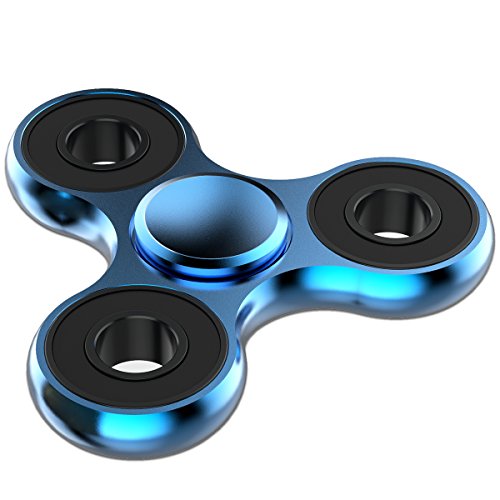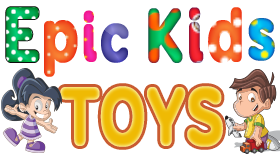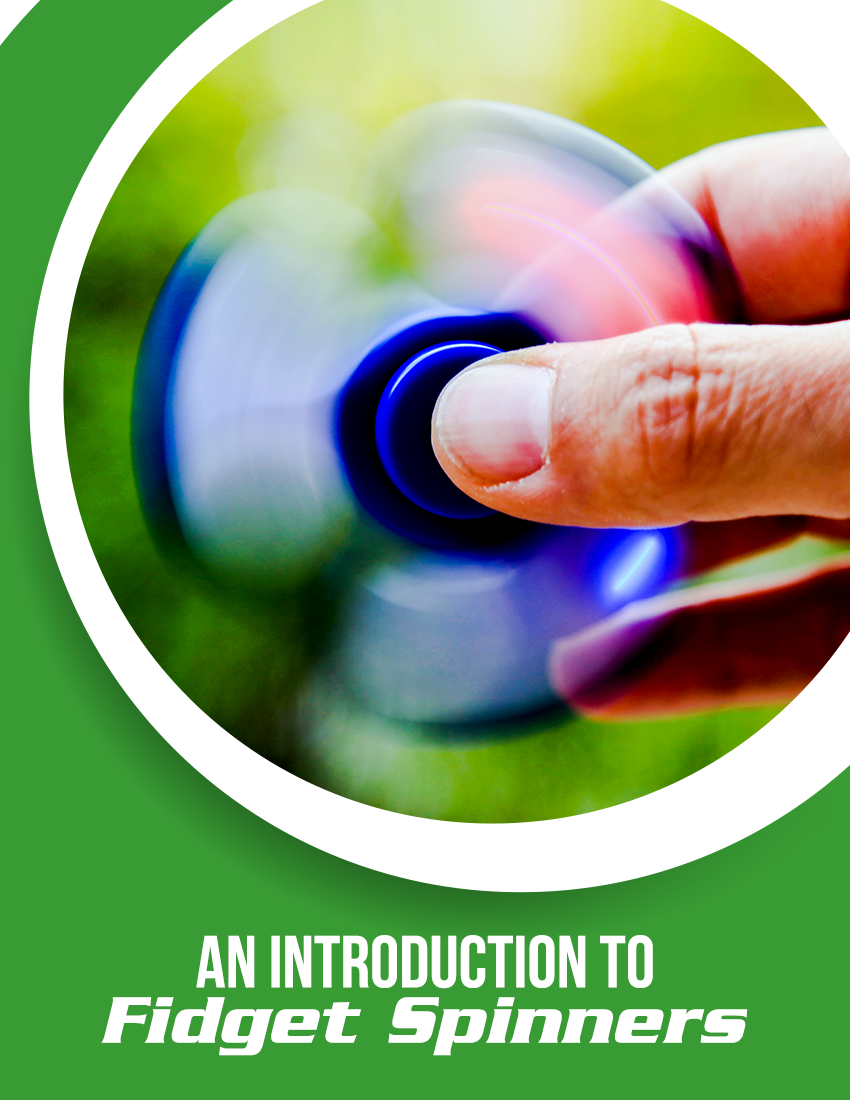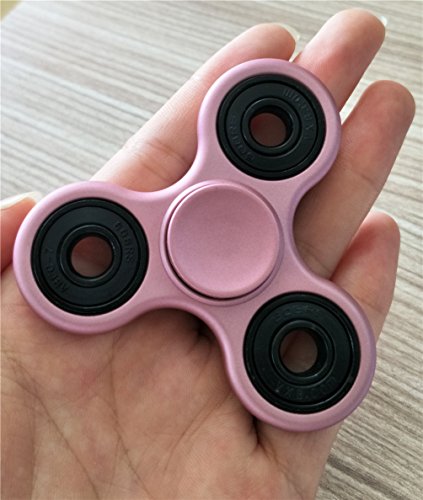Unless you have been living under a rock, you have more than likely heard of fidget spinners. They are the latest craze to sweep through 2017, and unfortunately for teachers and parents all over the country, the summer has not been enough to let them run their course. Adults don’t seem to “get” them, and the kids and kids at heart seem to love that.
The fidget spinner is a toy of humble beginnings and a simplistic shape. It consists of two to four “prongs” attached to a central piece. Inside the central piece, there is a ball bearing that makes the prongs easy to spin, and…that’s about it. The entire point of the toy is to get the prongs to spin in a gyroscopic manner and in the most aesthetic way possible during the tricks that show them off. Nothing new, nothing completely out of the ordinary, so you might be wondering how in the world did this product go viral and more importantly, why.
Let’s start from the beginning. Fidget spinners were formerly claimed to be a part of a patent in 1993, but that patent ended up lapsing in 2005. The holder of the patent was interviewed later, and mentioned that the fidget spinner is not her creation. The true apparent source made himself known about ten years later in 2015. Scott McCoskery, an IT expert outside of Seattle and one of the millions of people who grow restless when they are doing something and have to stop using their hands suddenly, created something to keep his hands busy while he was on phone calls. In his mind, the toy that he came up with would keep his hands moving so that he wouldn’t lose his pace until he could get back to work. This was the original fidget spinner, but instead of the traditional three or four prongs on the side, it had only two. Due to its resemblance to a torque wrench, when he opened up his GoFundMe page in October of 2015, he had dubbed it the TorqBar. Catchy enough, but apparently it wasn’t quite enough. His goal was missed by $11,000 USD, and by all logic, that should have been the end of the fidget spinner.
Except that McCoskery has never been one to give in easily, and now you can find fidget spinners everywhere, from custom fidget spinners on Silk Letter to the local dollar store. In reality, this makes logical sense, when you consider the genre of this toy. The best “older” toy that you can possibly compare the fidget spinner is the one toy many millennials and baby boomers can actually agree upon: the yoyo.
Of course, there are going to be a lot of questions on how this weird toy could possibly be a relative to the yoyo, but consider the following: The major appeal that the yoyo had was not just the drop and sending it flying back up to your hand. If you are like many other people, you took the time to learn several tricks, such as the “around the world,” “walk the dog,” “crazy eights,” and “double or nothing.” It’s quite the same with fidget spinners. In fact, YoYoTricks.com had made a subsite, Spinner Tricks, and they even made a compilation on what fidget spinners can do in comparison to their grandfather toy. There, you can see them tossing them in the air, balancing them on their heads or noses, and a variety of other interesting tricks of dexterity that remind many of some of the basic yoyo tricks that an expert might do mindlessly.
How they got popular is more a matter of how they possibly couldn’t have gotten popular. As we all already know, it’s a bit impossible to pick what will be the next big thing for children all over the country, but when we see add a few other factors, you’ll find that the recipe for success made this more of a sooner rather than later. Some general rules of thumb to increase the odds that a toy will be popular have been established, and fidget spinners fit so neatly into the niche by design alone that it was just a matter of getting them out to the market. Fidget spinners come in a variety of colors and finishes, which will encourage children to collect and to trade fidget spinners as they find that their friends have a glitterier one or that they have a spinner that will spin longer. The general size of a fidget spinner makes them easy for a child to fit in their pocket, which makes it easy to transport to their friend’s house, to the school yard, and easy to slip into a bookbag at the end of the day and transport home. In fact, their size and shape makes it easy to slip three or four into a pocket, and with the general retail price being typically less than the allowance they might make in a week, they are easily affordable and compact, so they may be tempted to just buy more and more in order to get more to collect for themselves or to trade off to friends. With these factors in mind, one should also consider the official reason that they were created in the first place to get a good idea of what edge that it had from conception.
The Torqbar, the fidget spinner prototype, was explicitly designed so that one of the millions of people in America had something to do with idle hands. This has been a problem for generations. Fidgeting is typically an act of nervousness, boredom, or other forms of mental agitation. Whether it stems from an anxiety disorder, ADHD, or just as a sign of boredom, fidgeting is a completely normal act, though a lot of fidgety habits are considered annoying or distracting. This has taken to the rise of a variety of toys, especially for the school aged children, in order to prevent some of the more annoying habits. After all, there have been studies proving that children that are allowed to give into fidgeting with their hands tend to perform better on memory tests. It’s also important to note that for autistic children and children who are attention deficit, a fidget spinner in theory will be a bit of an escape for the anxiety that builds up as they are asked to sit still, thus providing some much-needed relief to caretakers as well at the child themselves.
In a twist of irony, however, fidget spinners have been deemed distracting to instructors all over the country, and 32% of schools nationwide have gone as far as to ban them from school premises.There are quite a few theories as to why this is the case. One of the more popular theories is that while students who benefit from fidget spinners might be contented with spinning in a more subdued way, the insane popularity of the toy had gotten it into the hands of other students, who are wanting to do the tricks during class, which takes their attention right off of their instructors and on to the fidget spinner. Naturally, as the tricks get a bit more sophisticated, a lot more attention will go on to the spinner from the students around them, and before you know it, a perfectly innocent toy will be distracting the classroom and possibly even the teacher as well. Another theory is that due to the noise that a fidget spinner makes as the ball bearing moves might get a little annoying en masse, and disturb the peace of the classroom and make it a little more difficult for a teacher to teach, as it interrupted his or her concentration. Also, a likely theory is that children are likely to be trading them on the school yard, are likely to “borrow” each other’s fidget spinners, possibly without permission, and have the potential to cause school yard fights, much like how some fifteen years ago Pokémon cards have been regulated by the same schools that are banning fidget spinners.

There is a bit of a light at the end of the tunnel for the fidget spinners’ critics, however: Fidget spinners seem to be on the decline. As of July, purchases of fidget spinners have been reduced to half of what they were at their peak in early 2017. Soon, just like Rubik’s cubes and hula hoops, fidget spinners will be put away for good, only to come out of their hiding places years later in order to bring about nostalgia of this point of their lives. Just like every toy craze before it, there will be kids who stick with it and develop dexterity as they develop the skills of their tricks, but for the rest of them, fidget spinners will find their way into the crevices of their mind, tucked away with fads past, ready to make room for the next big thing.
For those that actually benefit from fidget spinners, however, it is the opinion of experts that you will not be left in a lull. If you go on to Amazon, you will find that within the top fifty toys searched for and purchased, fidget toys dominate the list to the point of representing the list consistently into the high forties. Unlike fidget spinners, which have been a bit overlooked in studies and working mostly on theory, you will find several toys that are a little less popular, but have the studies put in behind them. Keep in mind, if that is something that matters to you as a consumer, that while fidget spinners lack the studies that are usually desired for the genre of toy, the theories involved are in full practice and should make it just as effective as any other choice in fidgeting toys at a fraction of the price in a majority of cases. If you think that your child might benefit from a fidget spinner, it certainly is not going to be too much out of your pocket to check. Here are a few signs to look for when you are considering a fidget spinner:
As the name implies, when your child is sitting still, check for how they fidget. While fidget spinners will not do much to help a child whose fidgeting is focused on their feet and legs, if they are more likely to fidget with their hands, a fidget spinner might be helpful in their case. A few common hand-based fidgets are tapping a pen or pencil against a surface in a rhythm, wringing their hands together, playing with their hair, and doodling. While there is nothing inherently wrong with doodling, there are many teachers who will find doodling to be an insulting matter, especially as doodles turn into doing full-sized art projects in the middle of their class. While it is a fun hobby, it may be best for them to wait to draw until study hall or at home, where they can actually focus on improving their art. In the case of the fidgety doodlers, you actually have two routes to go down, but for the pen tappers, groomers, and fingernail pickers, a fidget spinner might be good for breaking these habits.
If your child is ADHD, autistic, or prone to acute stress disorder, you are probably more familiar to your child’s meltdowns than a stranger on the internet, considering how different the meltdowns can be from person to person. If your child’s meltdowns are actually distractible and can be prevented by diversion, a fidget spinner is an easily accessible distraction and are generally perfect for keeping them under control until you get them into a familiar and more controllable environment. It should be noted that fidget spinners can also be useful for children who tend to get social anxiety in the proper settings, but might actually give them something that will consume their attention and give them an “out” to isolate themselves, so try to use it sparingly or make sure to take note if he or she is spending more time and energy with the fidget spinner than trying to make friends and get over their anxiety.
Fidget spinners are also good for students who are in general needing to find a point of “focus” in order to get themselves able to pay attention, which means that this is a double-whammy for children with ADHD. Typically speaking (once again, ADHD seems to be unique to the person who has it), ADHD makes a child hyperaware of anything and everything that comes into his or her perspective. This typically means that the newest thing that affects their senses will be at the forefront of their mind. Since a fidget spinner uses three of the five senses, it can quickly take hold of a child’s attention, which might be able to ground them long enough to get their attention back where it’s needed. The downside is that it may become the sole focus of attention, which is when it becomes the distraction that many teachers seem to think it is, and it may become a point of annoyance to a parent who is trying to communicate with their child while they are playing with it. For that reason, it’s imperative that you know how your child’s ADHD tends to rear its head, as it can be the difference between finding a proper “fidget buster” for him or her or finding yet another distraction from their responsibilities.
As tempting as it might be, if your child is actually more apathetic than anxious in their fidgeting, then odds are you should not give them a fidget spinner. While boredom is a typical cause of fidgeting, an apathetic child will likely look for any sort of distraction that they can come up with, and are more likely to be the distraction in class with their fidget spinner than the child who is trying to spin away test anxiety.
If your child falls into one of the first two categories, it might be best to bring it up to their teachers and principals in order to make sure that they have them in class. Typically speaking, if you have some sort of note from their doctors, it will be considered an exception to the rising fidget spinner ban and they will have it when they need it. However, bear in mind that the final word is theirs and theirs alone. You should not try to undermine their authority just in case your child chooses to use their permission to be a distraction in class. The best course of action is to meet with them as early as possible, discuss the policies, and explain your child’s unique situation. Typically speaking, children requiring special education seem to be more likely to have their fidget spinners in class and use them in a non-disruptive manner.
With fidget spinners having already peaked in popularity, it’s going to be up to the peripheral market if they remain as accessible and as cheap as they are currently. While they are excellent boredom busters and a great collectible and ice breaker among the more social, you will find that their design makes them a more valuable toy for those who are not adjusting in quite the same way, offering a calming factor that will help them focus or even avoid a chaotic and public meltdown. For the latter, a fidget spinner could very soon become as classic as the Rubik’s cube instead of fading into obscurity.
As it were, you might want to pick up a fidget spinner before the market finally catches up to the statistics marking it as on its way out, whether you are an adult who likes to perfect their fine motor skills via the tricks that you can do, or if you are purchasing for a child who might benefit from it. You are going to hear children looking for the next fad not begging for them quite as often anymore, and soon they may just be a nostalgic toy that you will find on a list of “only ’10 kids will remember” listicles of the future. Make sure that you are educated on the rules of the places that your child goes to make sure that their fidget spinner is not going to be taken away, and make sure that you are investing in them wisely – sure, that $200 holographic spinner seems awesome right now and you think that when you’re bored of it you can earn your money back, but just remember that in kids’ crazes, by the time the adults with the money for a $200 spinner decide that they totally “get it” and it’s worth the money, it’s already on the way out and they’re ready for the next big thing.
Click Here To Check Out Our Store For Fidget Spinners
Novelty And Gag Toys
SAMSHAO Fidget Spinners Aeroship Rainbow Tri-Spinner Copper (Rainbow)








